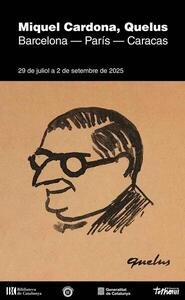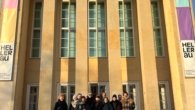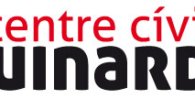
Miquel Cardona, Qelus: Barcelona – Paris – Caracas / Exhibitions / Visit us / Start
Miquel Cardona i Martí (Barcelona 1903 – Caracas, 1964) was a cartoonist, screenwriter, graphic humorist and poster artist. Known artistically as Quelus – an abbreviated Latinization of his first name – he often signed with this pseudonym accompanied by the drawing of a rose, in homage to his wife, Rosa. He was the son of the renowned shorthand Rafael Cardona i Mercader.
He studied general at the Pies Schools in Barcelona and trained in arts in the Polytecnicum and the school of the Llotja. He initially signed his works with the initial and first surname, but to avoid increasing censorship, he definitively adopted the pseudonym of Qelus.
An admirer of Xavier Nogués and Josep Obiols, the work of Qelus shows the influence of these two artists, although over time it consolidated its own style, of French spirit and very characteristic of the time. After the Civil War, he went into exile in Paris, where he continued his artistic activity and deepened the study of folklore. In 1947 he settled in Caracas, where he nationalized Venezuelan and became a prominent figure in the field of local folklore. He served as the Deputy Director of the Folklore Institute of Caracas, an institution that dedicated a room after his death. Posthumously, his work was published Folklore Temas Venezolanoconsidered fundamental in this field.
In the 1930’s, Qelus was one of the most prolific cartoonists in the magazine Tbo And he collaborated with virtually all Catalan publications of the time: Beautiful land, From here and there, Cincopolis, The bumblebee, In Patufet, The advertising, George, The turret, The Estevet, The child, Papiteand Virroletamong others.
He participated in numerous collective exhibitions of humorous drawing, as well as in oil painting samples, often with satirical theme. He also illustrated children’s books, including 3 to the pole by Angel Ferran and an adaptation for children from the Canyon by Jacint Verdaguer. During exile in Paris, he collaborated with Catalan diaspora magazines as Catalonia and For Cataloniawhile continuing his studies on folklore. In Caracas, he published sporadically in the satirical magazine The azul morrocoy.
Quelus can be considered heir to the clear line, a style characterized by the use of a clean and regular black stroke to delimit characters and scenes. The scenery is often treated with detailed realism, while the characters take more cartoonish forms.
Thanks to a generous family donation, the Biblioteca de Catalunya retains more than 500 pieces, many of which are original: pen drawings, pencils, pastels, gousses, caricatures published in the press, portraits, auques, congratulations, figurines and advertising posters.











